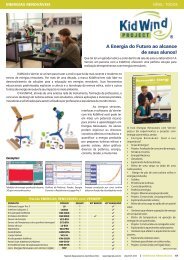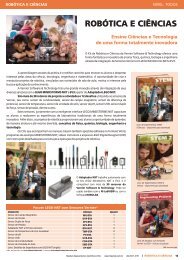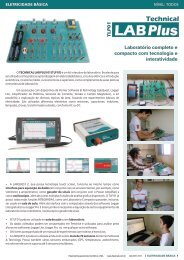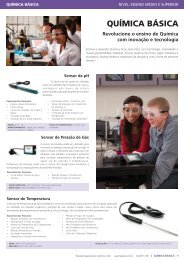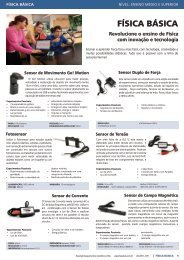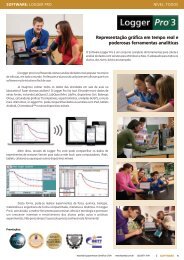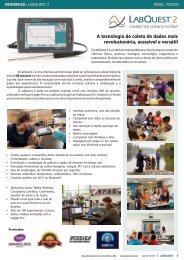Heliocentris - Energias Renováveis
You also want an ePaper? Increase the reach of your titles
YUMPU automatically turns print PDFs into web optimized ePapers that Google loves.
Experiment Guide<br />
06.13/JT | Printed in Germany<br />
Desorption characteristic of metal hydride canisters<br />
ACADEMIA OFFERING<br />
How does the H 2 volume flow rate influence the desorption<br />
behavior of metal hydride canisters?<br />
In order to learn how the charge capacity of the desorption characteristic<br />
of metal hydride canisters is influenced, the system should be<br />
operated with a high load point and, in the process, be supplied one<br />
time by one hydride metal hydride canister and one time by two metal<br />
hydride canisters.<br />
Material and conditions<br />
• Compressed gas cylinder<br />
• Cable for the start-up supply<br />
• 3 metal hydride canisters with equal fill level • IEC power cable<br />
• Power supply unit with red / black patch cords • Pencil<br />
• Cable for the hydrogen valve<br />
• Instruction manual read<br />
• Hydrogen quick coupling bridge<br />
• Quick Guide HOW TO PREPARE THE SYSTEM TO<br />
• 1 red and 1 black power cable (long)<br />
EXPERIMENT AND SHUT IT DOWN AFTERWARDS<br />
• 1 red and 1 black power cable (short)<br />
The experiment is described in the following with unregulated DC<br />
TIP output. It can also be performed with regulated DC output or AC<br />
output. For the DC output variant, choose a load point of 600 W.<br />
For the AC output variant, you need a regulated AC load (500 W).<br />
In order to be able to operate the system immediately with a high<br />
load point, it must run warm as a preparatory measure. Preparation<br />
of the system:<br />
1. Set up the experiment as illustrated.<br />
− All metal hydride canisters are closed, the system is supplied<br />
with hydrogen externally.<br />
CAUTION Danger of injury due to explosion! Perform a leak<br />
test each time before commissioning.<br />
2. Start the system (see Quick Guide).<br />
3. Set the function mode to MANUAL.<br />
4. START THE FUEL CELL.<br />
5. Switch on the load input of the electronic load.<br />
6. Slowly turn the current up to 35 A or 800 W.<br />
− Run the system for 2 minutes.<br />
7. Shut down the Nexa ® Training System (see Quick Guide).<br />
Nexa® Training System - Experiment Guide 19<br />
FROM THEORY …<br />
Higher Education<br />
Nexa® Training System<br />
1.2 kW Fuel Cell Training System<br />
for Hybrid Applications<br />
The Nexa® Training System allows practical preparatory<br />
experiments in the design and hybridization of an energy<br />
system using fuel cell technology in your laboratory. With<br />
the modular design, students can investigate and influence<br />
the fuel cell module, the hydrogen storage canisters, the<br />
battery and the power electronics on an individual basis and<br />
combine the modules with one another.<br />
Includes<br />
Instructional<br />
Materials<br />
Extensive instructional material supports instructors for class<br />
preparation and instruction. Pre-configured experiments and software-supported<br />
experimentation make it easier for your students<br />
to work with the complex system.<br />
135 cm<br />
Key Features<br />
»»<br />
Realistic training system with a 1.2 kW fuel cell<br />
with battery hybridization<br />
»»<br />
Learning and experimenting software with automatic generation<br />
of characteristic curves<br />
»»<br />
Central visualization and control of all system processes via computer<br />
»»<br />
Two battery capacities for experiment setups<br />
»»<br />
Output for DC and AC power<br />
»»<br />
Integrated hydrogen storage canister<br />
»»<br />
Flexible use of the system, standing and sitting<br />
»»<br />
Extensive learning and experimenting materials<br />
Software<br />
Software<br />
»»<br />
System Overview<br />
»»<br />
Efficiency Analysis<br />
»»<br />
Time Curve<br />
»»<br />
Freely configurable measurements<br />
»»<br />
Visualization of characteristic curves<br />
»»<br />
Selection of manual and automated experiments<br />
System Overview<br />
Measurements<br />
Sample Experiments<br />
System design for special applications:<br />
»»<br />
Backup<br />
»»<br />
Emergency power supply (UPS)<br />
»»<br />
Autonomous power supply<br />
Examination of the<br />
operating behavior of:<br />
»»<br />
Fuel cell module<br />
»»<br />
DC converter<br />
»»<br />
Battery module<br />
A tention: Use and replication of the image data is only permitted with written approval by LECHUZA, write to pr@lechuza.com |<br />
Nexa® Training System<br />
Nexa® Trainin<br />
Nexa® Training i<br />
System<br />
e a<br />
Nexa® Training System<br />
H 2 Desorption Experiment<br />
Product Overview<br />
Nexa® Training System<br />
»»<br />
Nexa® DC1200 power electronics module »»<br />
H ²<br />
storage module<br />
»»<br />
Electronic load<br />
»»<br />
System control via touchscreen<br />
»»<br />
Battery module<br />
»»<br />
Software + CD<br />
»»<br />
All-in-one PC<br />
Art. no. 793 *<br />
Accessories*: Hydrogen supply – 200 bar H ²<br />
connection kit<br />
Direct supply from H ²<br />
compressed gas cylinders and filling of the H ²<br />
storage module Art. no. 736<br />
Dimensions (W x H x D): 600 x 1,350 x 600 mm, weight: approx. 150 kg.<br />
*<br />
Only available in combination with a hydrogen connection kit from <strong>Heliocentris</strong>.<br />
12 Nexa® Training System





